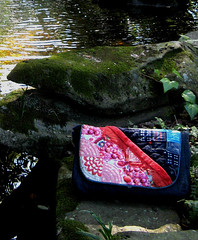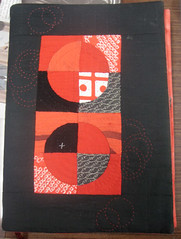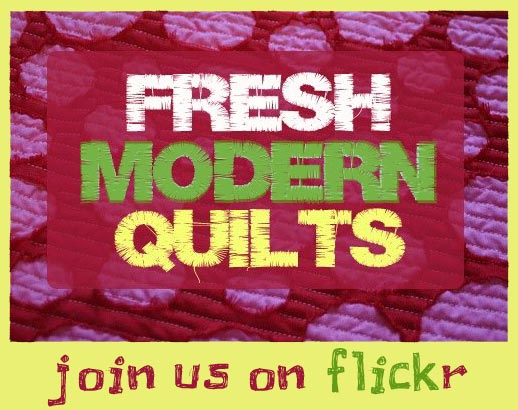
My first big sewing project was a shoulder/messenger style bag. Rik, my husband, helped me with the design of this bag, combining functionality with style. For me, it’s all about the colors and patterns, for Rik, it’s all about making something that is useful and serves a purpose. Since this bag was to be used during my commutes to work by bicycle, Rik thought that it was important to make the cover of the bag in a pattern similar to a road sign, something that is easy to see from far away. We decided on a diagonal design using a gradation of bright reds to white on one side, and a gradation of dark colors to light colors on the other. With the sudden switch from bright red to dark blue, this effectively created a design that would stand out from far away.
The choice of material was left to me. I love a variety of materials. This time, I used a red stripe of soft and furry Minky as the centerpiece. On the red half, I used some material by
Amy Butler, some Japanese silk kimono materials, and others. These were all hand pieced together in a pattern known as Drunkard's Path, a tricky piecing technique that consists of mostly curves sewn together. The blue side of the bag was made almost entirely with antique “
kasuri”, a Japanese material that was used to make everyday kimonos in the past. The “kasuri” I used was made of wool, although often “kasuri” is cotton.
After the piecework was finished, I basted the creation to some batting and used a scrap piece of material for the backside. I now hand quilted all the various lines. After I finished this, it was time for the really tricky part – putting the bag together into a functional shape.
Using my second hand sewing machine, somehow I managed to put things together into a bag like shape, although I was left slightly unsatisfied with the result. The size was right, but the front panel was too big and bulky and difficult to open and close in a jiffy. If I were to make it again, I would make it with the opening at the top. This would be more convenient, plus the front design would be better positioned.

Throughout the process of making this bag, I had the invaluable advice of my sewing teacher. Although she was baffled by my combination of materials and colors, she was able to help me put the whole thing together. In Japan, “kasuri” is generally material favored by the elderly. I think young people look at “kasuri” and immediately think of their grandmothers. For me, a “gaijin” or foreigner living in Japan, I have none of these preconceptions about the material. I love the indigo color which comes from a natural dye, as well as the simple weaves and patterns of the fabric.
Initially I made this bag with the intention of using it for transporting my laptop computer. Although I occasionally use it for this purpose, generally, I simply use it as my work bag. It is roomy enough for carrying my lunch, some books and the other junk that seems to collect in people’s bags.
Some of my friends have remarked that I could have sold this creation. Considering all the time and effort that went in to making this bag, I can’t imagine an appropriate price. One of my junior high school students complimented me by saying that she would even pay $50 for it. I sighed and wondered about the futility of living in a world where handmade products are so undervalued. After all in Japan, as in most of the developed world, almost everything is made in China, where labor is cheap, working conditions are abominable, standards are low and production is high. In this present economic situation making things by hand does not seem to make any sense. Still, I think there is a point to it. Rik also thinks it is great to learn new skills and to exercise ones creative mind. After all, we just can’t attach a price to everything.















